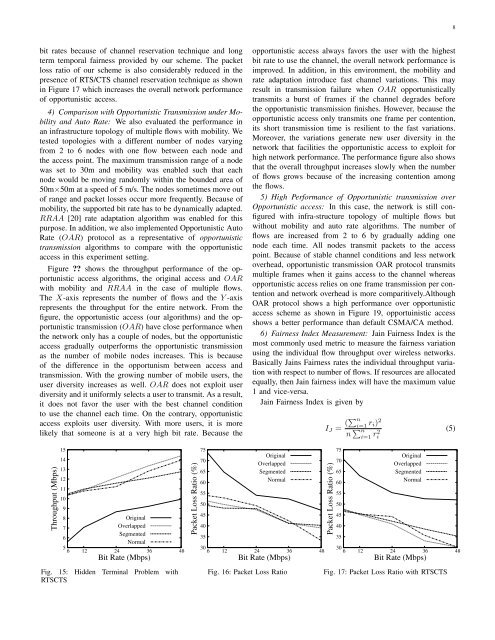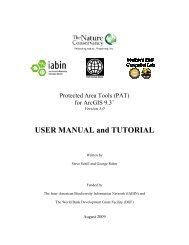Tech Report - University of Virginia
Tech Report - University of Virginia
Tech Report - University of Virginia
Create successful ePaper yourself
Turn your PDF publications into a flip-book with our unique Google optimized e-Paper software.
8bit rates because <strong>of</strong> channel reservation technique and longterm temporal fairness provided by our scheme. The packetloss ratio <strong>of</strong> our scheme is also considerably reduced in thepresence <strong>of</strong> RTS/CTS channel reservation technique as shownin Figure 17 which increases the overall network performance<strong>of</strong> opportunistic access.4) Comparison with Opportunistic Transmission under Mobilityand Auto Rate: We also evaluated the performance inan infrastructure topology <strong>of</strong> multiple flows with mobility. Wetested topologies with a different number <strong>of</strong> nodes varyingfrom 2 to 6 nodes with one flow between each node andthe access point. The maximum transmission range <strong>of</strong> a nodewas set to 30m and mobility was enabled such that eachnode would be moving randomly within the bounded area <strong>of</strong>50m×50m at a speed <strong>of</strong> 5 m/s. The nodes sometimes move out<strong>of</strong> range and packet losses occur more frequently. Because <strong>of</strong>mobility, the supported bit rate has to be dynamically adapted.RRAA [20] rate adaptation algorithm was enabled for thispurpose. In addition, we also implemented Opportunistic AutoRate (OAR) protocol as a representative <strong>of</strong> opportunistictransmission algorithms to compare with the opportunisticaccess in this experiment setting.Figure ?? shows the throughput performance <strong>of</strong> the opportunisticaccess algorithms, the original access and OARwith mobility and RRAA in the case <strong>of</strong> multiple flows.The X-axis represents the number <strong>of</strong> flows and the Y -axisrepresents the throughput for the entire network. From thefigure, the opportunistic access (our algorithms) and the opportunistictransmission (OAR) have close performance whenthe network only has a couple <strong>of</strong> nodes, but the opportunisticaccess gradually outperforms the opportunistic transmissionas the number <strong>of</strong> mobile nodes increases. This is because<strong>of</strong> the difference in the opportunism between access andtransmission. With the growing number <strong>of</strong> mobile users, theuser diversity increases as well. OAR does not exploit userdiversity and it uniformly selects a user to transmit. As a result,it does not favor the user with the best channel conditionto use the channel each time. On the contrary, opportunisticaccess exploits user diversity. With more users, it is morelikely that someone is at a very high bit rate. Because theopportunistic access always favors the user with the highestbit rate to use the channel, the overall network performance isimproved. In addition, in this environment, the mobility andrate adaptation introduce fast channel variations. This mayresult in transmission failure when OAR opportunisticallytransmits a burst <strong>of</strong> frames if the channel degrades beforethe opportunistic transmission finishes. However, because theopportunistic access only transmits one frame per contention,its short transmission time is resilient to the fast variations.Moreover, the variations generate new user diversity in thenetwork that facilities the opportunistic access to exploit forhigh network performance. The performance figure also showsthat the overall throughput increases slowly when the number<strong>of</strong> flows grows because <strong>of</strong> the increasing contention amongthe flows.5) High Performance <strong>of</strong> Opportunistic transmission overOpportunistic access: In this case, the network is still configuredwith infra-structure topology <strong>of</strong> multiple flows butwithout mobility and auto rate algorithms. The number <strong>of</strong>flows are increased from 2 to 6 by gradually adding onenode each time. All nodes transmit packets to the accesspoint. Because <strong>of</strong> stable channel conditions and less networkoverhead, opportunistic transmission OAR protocol transmitsmultiple frames when it gains access to the channel whereasopportunistic access relies on one frame transmission per contentionand network overhead is more comparitively.AlthoughOAR protocol shows a high performance over opportunisticaccess scheme as shown in Figure 19, opportuinistic accessshows a better performance than default CSMA/CA method.6) Fairness Index Measurement: Jain Fairness Index is themost commonly used metric to measure the fairness variationusing the individual flow throughput over wireless networks.Basically Jains Fairness rates the individual throughput variationwith respect to number <strong>of</strong> flows. If resources are allocatedequally, then Jain fairness index will have the maximum value1 and vice-versa.Jain Fairness Index is given byI J = (∑ ni=1 r i) 2n ∑ ni=1 r2 i(5)Throughput (Mbps)15141312111098Original7Overlapped6SegmentedNormal56 12 24 36 48Bit Rate (Mbps)Fig. 15: Hidden Terminal Problem withRTSCTSPacket Loss Ratio (%)757065605550454035OriginalOverlappedSegmentedNormal306 12 24 36 48Bit Rate (Mbps)Fig. 16: Packet Loss RatioPacket Loss Ratio (%)757065605550454035OriginalOverlappedSegmentedNormal306 12 24 36 48Bit Rate (Mbps)Fig. 17: Packet Loss Ratio with RTSCTS
















